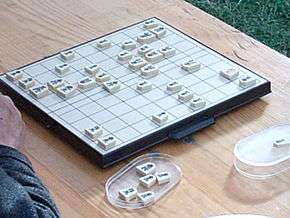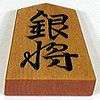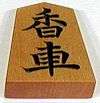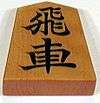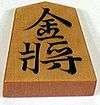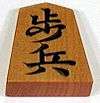Shogi
|
A game of shogi using a magnetic travel set. Captured pieces in the tray (bottom-center) can be dropped into play on the board by the capturer. | |
| Genre(s) |
Board game Abstract strategy game |
|---|---|
| Players | 2 |
| Age range | 5+ |
| Setup time | < 2 minutes |
| Playing time | 30 mins. to 2 hours (typically) |
| Random chance | None |
| Skill(s) required | Strategy, tactics |
| Synonym(s) |
Japanese chess The Generals' Game |
Shogi (将棋 shōgi) (/ˈʃoʊɡiː/, Japanese: [ɕo̞ːɡi] or [ɕo̞ːŋi]), also known as Japanese chess or the Generals' Game, is a two-player strategy board game in the same family as Western (international) chess, chaturanga, makruk, shatranj, janggi and xiangqi, and is the most popular of a family of chess variants native to Japan. Shōgi means general's (shō 将) board game (gi 棋).
The earliest predecessor of the game, chaturanga, originated in India in the 6th century, and sometime in the 10th to 12th centuries xiangqi (Chinese chess) was brought to Japan where it spawned a number of variants. Shogi in its present form was played as early as the 16th century, while a direct ancestor without the "drop rule" was recorded from 1210 in a historical document Nichūreki, which is an edited copy of Shōchūreki and Kaichūreki from the late Heian period (c. 1120).
According to The Chess Variant Pages :[1]
Perhaps the enduring popularity of shogi can be attributed to its ‘drop rule’; it was the first chess variant wherein captured pieces could be returned to the board to be used as one's own. David Pritchard credits the drop rule to the practice of 16th century mercenaries who switched loyalties when captured—no doubt as an alternative to execution.
Equipment
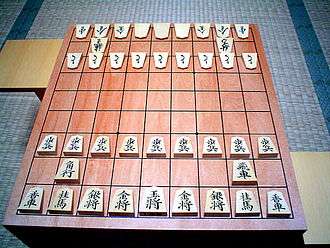
Two players, Sente 先手 (Black; more literally, person with the first move) and Gote 後手 (White; person with the second move), play on a board composed of rectangles in a grid of 9 ranks (rows) by 9 files (columns). The rectangles are undifferentiated by marking or color. The board is nearly always rectangular; square boards are uncommon. Pairs of dots mark the players' promotion zones.
Each player has a set of 20 wedge-shaped pieces of slightly different sizes. Except for the kings, opposing pieces are undifferentiated by marking or color. Pieces face forward (toward the opponent's side); this shows who controls the piece during play. The pieces from largest (most important) to smallest (least important) are:
Several of these names were chosen to correspond to their rough equivalents in international chess, and not as literal translations of the Japanese names.
Each piece has its name written on its surface in the form of two kanji (Chinese characters used in Japanese), usually in black ink. On the reverse side of each piece, other than the king and gold general, are one or two other characters, in amateur sets often in a different color (usually red); this side is turned face up during play to indicate that the piece has been promoted.
The suggestion that the Japanese characters have deterred Western players from learning shogi has led to "Westernized" or "international" pieces which use iconic symbols instead of characters. Most players soon learn to recognize the characters, however, partially because the traditional pieces are already iconic by size, with more powerful pieces being larger. As a result, Westernized pieces have never become popular. Bilingual pieces with both Japanese characters and English captions have been developed.
Following is a table of the pieces with their Japanese representations and English equivalents. The abbreviations are used for game notation and often when referring to the pieces in speech in Japanese.
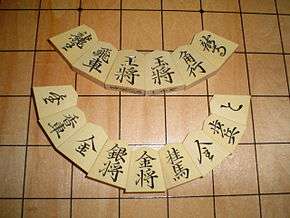
| English name | Image | Kanji | Rōmaji | Meaning | Abbreviations | Betza notation | ||
|---|---|---|---|---|---|---|---|---|
| King (higher ranked player or reigning champion) | | 王將 | ōshō | king general | K | 王 | ō | K |
| King (lower ranked player or challenger) | | 玉將 | gyokushō | jeweled general | K | 玉 | gyoku | K |
| Rook | | 飛車 | hisha | flying chariot | R | 飛 | hi | R |
| Promoted rook ("Dragon") | | 龍王 | ryūō | dragon king | +R | 龍 or 竜* | ryū | FR |
| Bishop | | 角行 | kakugyō | angle mover | B | 角 | kaku | B |
| Promoted bishop ("Horse") | | 龍馬 | ryūma or ryume | dragon horse | +B | 馬 | uma | WB |
| Gold general ("Gold") | | 金將 | kinshō | gold general | G | 金 | kin | WfF |
| Silver general ("Silver") | | 銀將 | ginshō | silver general | S | 銀 | gin | FfW |
| Promoted silver | | 成銀 | narigin | promoted silver | +S | (全) | — | WfF |
| Knight | | 桂馬 | keima | cassia horse | N | 桂 | kei | ffN |
| Promoted knight | | 成桂 | narikei | promoted cassia | +N | (圭 or今) | — | WfF |
| Lance | | 香車 | kyōsha | incense chariot | L | 香 | kyō | fR |
| Promoted lance | | 成香 | narikyō | promoted incense | +L | (杏 or 仝) | — | WfF |
| Pawn | | 歩兵 | fuhyō | foot soldier | P | 歩 | fu | fW |
| Promoted pawn ("tokin") | | と金 | tokin | reaches gold | +P | と (or个) | to | WfF |
* The kanji 竜 is a simplified form of 龍.
English speakers sometimes refer to promoted bishops as horses and promoted rooks as dragons, after their Japanese names, and generally use the Japanese term tokin for promoted pawns. Silver generals and gold generals are commonly referred to simply as silvers and golds.
The characters inscribed on the reverse sides of the pieces to indicate promotion may be in red ink, and are usually cursive. The characters on the backs of the pieces that promote to gold generals are cursive variants of 金 'gold', becoming more cursive (more abbreviated) as the value of the original piece decreases. These cursive forms have these equivalents in print: 全 for promoted silver, 今 for promoted knight, 仝 for promoted lance, and 个 for promoted pawn (tokin). Another typographic convention has abbreviated versions of the original values, with a reduced number of strokes: 圭 for a promoted knight (桂), 杏 for a promoted lance (香), and the 全 as above for a promoted silver, but 全 for tokin.
Setup and gameplay
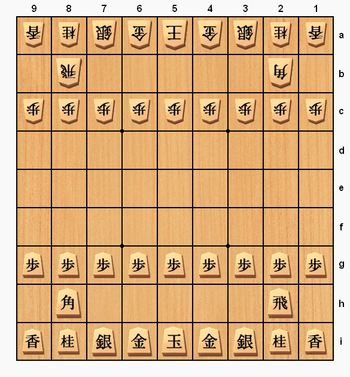
Each player sets up his pieces facing forward (toward his opponent).
- In the rank nearest the player:
- the king is placed in the center file;
- the two gold generals are placed in files adjacent to the king;
- the two silver generals are placed adjacent to each gold general;
- the two knights are placed adjacent to each silver general;
- the two lances are placed in the corners, adjacent to each knight.
- That is, the first rank is
L N S G K G S N L - or
香 桂 銀 金 玉 金 銀 桂 香
- In the second rank, each player places:
- the bishop in the same file as the left knight;
- the rook in the same file as the right knight.
- In the third rank, the nine pawns are placed one per file.
|
|
Traditionally, the order of placing the pieces on the board is determined. There are two commonly used orders, the Ōhashi order 大橋流 and the Itō order 伊藤流.[2] Placement sets pieces with multiples (generals, knights, lances) from left to right in all cases, and follows the order:
- king
- gold generals
- silver generals
- knights
- In ito, the player now places:
- 5. pawns (left to right starting from the leftmost file)
- 6. lances
- 7. bishop
- 8. rook
- In ohashi, the player now places:
- 5. lances
- 6. bishop
- 7. rook
- 8. pawns (starting from center file, then alternating left to right one file at a time)
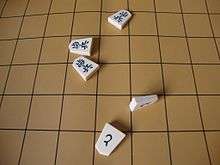
A furigoma 振り駒 'piece toss' is used to decide who moves first. One of the players tosses five pawns. If the number of tokins (promoted pawns, と) facing up is higher than unpromoted pawns (歩), then the player who tossed the pawns plays gote 後手 'white' (that is, they have the second move).[3] Usually, the higher ranked or defending champion performs the piece toss.
After the piece toss furigoma, the game proceeds. If multiple games are played, then players alternate turns for who goes first in subsequent games. (The terms "Black" and "White" are used to differentiate sides although there is no difference in the color of the pieces.) For each turn, a player may either move a piece that is currently on the board (and potentially promote it, capture an opposing piece, or both) or else drop a piece that has been previously captured onto a square of the board. These options are explained below.
Professional games are timed as in international chess, but professionals are never expected to keep time in their games. Instead a timekeeper is assigned, typically an apprentice professional. Time limits are much longer than in international chess (9 hours a side plus extra time in the prestigious Meijin title match), and in addition byōyomi (literally "second counting") is employed. This means that when the ordinary time has run out, the player will from that point on have a certain amount of time to complete every move (a byōyomi period), typically upwards of one minute. The final ten seconds are counted down, and if the time expires the player to move loses the game immediately. Amateurs often play with electronic clocks that beep out the final ten seconds of a byōyomi period, with a prolonged beep for the last five.
An illegal move results in an immediate loss of the game in professional and tournament shogi, even if play continued and the move was discovered later in game. However, if neither opposition nor third party points out, and the opposition later resigned, the resignation stands as the result.[4]
Rules
Movement
Most shogi pieces can move only to an adjacent square. A few may move across the board, and one jumps over intervening pieces.
The lance, bishop, and rook are ranging pieces: They can move any number of squares along a straight line limited only by intervening pieces and the edge of the board. If an opposing piece intervenes, it may be captured by removing it from the board and replacing it with the moving piece. If a friendly piece intervenes, the moving piece must stop short of that square; if the friendly piece is adjacent, the moving piece may not move in that direction at all.
|
|
| Notation | |
| ○ | Steps to an adjacent square |
| ☆ | Jumps to a non-adjacent square, bypassing any intervening piece |
| │ | Ranges along a straight line, crossing any number of empty squares |
| ─ | |
| \ | |
| / | |
A king (玉/王) moves one square in any direction, orthogonal or diagonal.
A rook (飛) moves any number of squares in an orthogonal direction.
A bishop (角) moves any number of squares in a diagonal direction. Because they cannot move orthogonally, the players' unpromoted bishops can reach only half the squares of the board, unless one is captured and then dropped.
A gold general (金) moves one square orthogonally, or one square diagonally forward, giving it six possible destinations. It cannot move diagonally backwards.
A silver general (銀) moves one square diagonally, or one square straight forward, giving it five possible destinations. Because an unpromoted silver can retreat more easily than a promoted one, it is common to leave a silver unpromoted at the far side of the board. (See Promotion).
A knight (桂) jumps at an angle intermediate to orthogonal and diagonal, amounting to one square straight forward plus one square diagonally forward, in a single move. Thus the knight has two possible forward destinations. The knight cannot move to the sides or in a backwards direction. The knight is the only piece that ignores intervening pieces on the way to its destination. It is not blocked from moving if the square in front of it is occupied, but neither can it capture a piece on that square. It is often useful to leave a knight unpromoted at the far side of the board. A knight must promote, however, if it reaches either of the two furthest ranks. (See Promotion.)
A lance (香) moves any number of squares directly forward. It cannot move backwards or to the sides. It is often useful to leave a lance unpromoted at the far side of the board. A lance must promote, however, if it reaches the furthest rank. (See Promotion.)
A pawn (歩) moves one square straight forward. It cannot retreat. Unlike international chess pawns, shogi pawns capture the same as they move. A pawn must promote if it arrives at the furthest rank. (See Promotion.) In practice, however, a pawn is usually promoted whenever possible. There are two restrictions on where a pawn may be dropped. (See Drops.)
All pieces but the knight move either horizontally, vertically, or diagonally. These directions cannot be combined in a single move; one direction must be chosen.
Every piece blocks the movement of all other non-jumping pieces through the square it occupies.
If a piece occupies a legal destination for an opposing piece, it may be captured by removing it from the board and replacing it with the opposing piece. The capturing piece may not continue beyond that square on that turn. Shogi pieces capture the same as they move.
Normally when moving a piece, a player snaps it to the board with the ends of the fingers of the same hand. This makes a sudden sound effect, bringing the piece to the attention of the opponent. This is also true for capturing and dropping pieces. On a traditional shogi-ban, the pitch of the snap is deeper, delivering a subtler effect.
It is common to keep captured pieces on a wooden stand (or komadai) which is traditionally placed so that its bottom left corner aligns with the bottom right corner of the board from the perspective of each player. It is not permissible to hide pieces from full view. This is because captured pieces, which are said to be "pieces in hand" (持ち駒 mochi goma), have a crucial impact on the course of the game.
Promotion
| A player's promotion zone (yellow)
| ||||||||||||||||||||||||||||||||||||||||||||||||||||||||||||||||||||||||||||||||||||||||||||||||||||
A player's promotion zone consists of the furthest one-third of the board – the three ranks occupied by the opponent's pieces at setup. The zone is typically delineated on shogi boards by two inscribed dots. When a piece is moved, if part of the piece's path lies within the promotion zone (that is, if the piece moves into, out of, or wholly within the zone; but not if it is dropped into the zone – see Drops), then the player has the option to promote the piece at the end of the turn. Promotion is indicated by turning the piece over after it moves, revealing the character of the promoted piece.
If a pawn or lance is moved to the furthest rank, or a knight is moved to either of the two furthest ranks, that piece must promote (otherwise, it would have no legal move on subsequent turns). A silver general is never required to promote, and it is often advantageous to keep a silver general unpromoted. (It is easier, for example, to extract an unpromoted silver from behind enemy lines; whereas a promoted silver, with only one line of retreat, can be easily blocked.)
Pieces that promote
| ||||||||||||||||||||||||||||||||||||||||||||||||||||||||||||||||||||||||||||||||||||||||||||||||||||
Promoting a piece changes the way it moves. The various pieces promote as follows:
- A silver general, knight, lance, or pawn has its normal power of movement replaced by that of a gold general.
- A rook or bishop keeps its original movement and gains the power to move one square in any direction (like a king). For a promoted bishop, this means it is able to reach any square on the board, given enough moves.
- A king or a gold general does not promote; nor can a piece that is already promoted.
When captured, a piece loses its promoted status. Otherwise promotion is permanent.
Promoted rook
A promoted rook ("dragon king", 龍王 Ryūō) moves as a rook or as a king, but not as both on the same turn. Alternate forms: 龍, 竜.
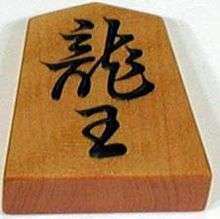 The dragon king |
|
Promoted bishop
A promoted bishop ("dragon horse", 龍馬 Ryūma) moves as a bishop or as a king, but not as both on the same turn. Alternate form: 馬.
 The dragon horse |
|
Promoted silver
A promoted silver (成銀 narigin) moves the same as a gold general. Alternate forms: 全, cursive 金.
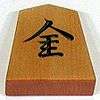 The promoted silver |
|
Promoted knight
A promoted knight (成桂 narikei) moves the same as a gold general. Alternate forms: 圭, 今, cursive 金.
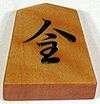 The promoted knight |
|
Promoted lance
A promoted lance (成香 narikyō) moves the same as a gold general. Alternate forms: 杏, 仝, cursive 金.
 The promoted lance |
|
Promoted pawn
A promoted pawn (と金 tokin) moves the same as a gold general. Alternate forms: と, 个.
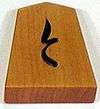 The promoted pawn |
|
Drops
Captured pieces are retained in hand, and can be brought back into play under the capturing player's control. On any turn, instead of moving a piece on the board, a player may select a piece in hand and place it—unpromoted side up and facing the opposing side—on any empty square. The piece is then one of that player's active pieces on the board and can be moved accordingly. This is called dropping the piece, or simply, a drop. A drop counts as a complete move.
A drop cannot capture a piece, nor does dropping within the promotion zone result in immediate promotion. Capture and/or promotion may occur normally, however, on subsequent moves of the piece.
A pawn, knight, or lance may not be dropped on the furthest rank, since those pieces would have no legal moves on subsequent turns. For the same reason, a knight may not be dropped on the penultimate (player's 8th) rank.
There are two additional restrictions when dropping pawns:
- Nifu (Japanese: 二歩): A pawn cannot be dropped onto a file (column) containing another unpromoted pawn of the same player (promoted pawns do not count). A player with an unpromoted pawn on every file is therefore unable to drop a pawn anywhere. For this reason it is common to sacrifice a pawn in order to gain flexibility for drops.
- Uchifuzume (Japanese: 打ち歩詰め): A pawn cannot be dropped to give an immediate checkmate. (Although other pieces may be dropped to give immediate checkmate.) A pawn may, however, be dropped to give immediate check.
It is common for players to swap bishops, which oppose each other across the board, early in the game. This leaves each player with a bishop in hand to be dropped later. The ability for drops in shogi give the game tactical richness and complexity. The fact that no piece ever goes entirely out of play accounts for the rarity of draws.
Winning
When a player's move threatens to capture the opposing king on the next turn, the move is said to give check to the king; the king is said to be in check. If a player's king is in check, that player's responding move must remove the check if possible;[5] if no such move exists, the checking move is also checkmate (tsumi 詰み) and immediately wins the game. The losing player should resign out of courtesy at this point, although in practice this rarely occurs, as players normally resign as soon as a loss is deemed inevitable.
To announce "check!" in Japanese, one says "ōte!" (王手). This is an influence of international chess and is not required, however, even as a courtesy.[6]
In professional and serious amateur games, a player who makes an illegal move loses immediately.
There are two other possible, if uncommon, ways for a game to end: repetition (千日手 sennichite) and impasse (持将棋 jishōgi):
- Repetition: If the same game position occurs four times with the same player to move, either player loses if his or her moves during the repetition are all checks (perpetual check), otherwise the game is considered a draw. For two positions to be considered the same, the pieces in hand must be the same as well as the positions on the board. The rule used to be that it happened if a sequence caused three repetitions.
- Impasse: The game reaches an impasse if both kings have advanced into their respective promotion zones and neither player can hope to mate the other or to gain any further material. If this happens, the winner is decided as follows: Each rook or bishop, promoted or not, scores 5 points for the owning player, and all other pieces except kings score 1 point each. A player scoring fewer than 24 points loses. (If neither player has fewer than 24, the game is no contest—a draw.) Jishōgi is considered an outcome in its own right rather than no contest, but there is no practical difference. In amateur games other rules for jishōgi can be applied (27 point count or try-rule).
As this impasse generally needs to be agreed on for the rule to be invoked, a player may refuse to do so, on the grounds that the player could gain further material or position before an outcome has to be decided. If that happens, one player may force jishōgi upon getting his king and all his pieces protected in the promotion zone.
In professional tournaments the rules typically require drawn games to be replayed with colors (sides) reversed, possibly with reduced time limits. This is rare compared to chess and xiangqi, occurring at a rate of 1–2% even in amateur games. The 1982 Meijin title match between Makoto Nakahara and Hifumi Kato was unusual in this regard, with jishōgi in the first game (only the fifth draw in the then 40-year history of the tournament), a game which lasted for 223 moves (not counting in pairs of moves), with 114 minutes spent pondering a single move, and sennichite in the sixth and eighth games. Thus this best-of-seven match lasted eight games and took over three months to finish; Black did not lose a single game and the eventual victor was Kato at 4–3.
Player rank and handicaps
Amateur players are ranked from 20 kyū to 1 kyū and then from 1 dan to 8 dan. Amateur 8 dan was only honorarily given to famous people. While it's now possible to win amateur 8 dan by actual strength (winning amateur Ryu-oh 3 times), this has yet to be achieved.
Professional players operate with their own scale, from 6 kyū to 3 dan for pro-aspiring players and professional 4 dan to 9 dan for formal professional players.[7] Amateur and professional ranks are offset (with amateur 4 dan being equivalent to professional 6 kyū).[8]
Handicaps
| 6-Piece Handicap △ pieces in hand: –
| ||||||||||||||||||||||||||||||||||||||||||||||||||||||||||||||||||||||||||||||||||||||||||||||||||||
| ▲ pieces in hand: – |
Games between players of disparate strengths are often played with handicaps. In a handicap game, one or more of White's pieces are removed from the setup, and instead White plays first.
Notation
Western notation
The method used in English-language texts to express shogi moves was established by George Hodges in 1976. It is derived from the algebraic notation used for chess, but differs in several respects. It is not used in Japanese language texts, as it is no more concise than traditional notation with kanji and two ciphers which was originated in Edo period. A typical move might be notated P-8f. The notation format has the following 5 part structure:
1 2 3 4 5 piece (origin) movement destination (promotion)
An example using all 5 parts is S7bx8c+. All parts are obligatory except for the origin and promotion parts. (Thus, most notation strings only contain 3 parts.) The origin part is only indicated when needed to resolve ambiguity. The promotion part is only needed when there is the possibility of promotion.
1. Piece. The first letter represents the piece moved: P for Pawn. Below are the abbreviations used.
Abbreviation English Term Japanese P pawn 歩 L lance 香 N knight 桂 S silver 銀 G gold 金 B bishop 角 R rook 飛 K king 玉/王
Promoted pieces are indicated by a + preceding the letter. For example, +P is a promoted pawn (と tokin), +R is a promoted rook (that is, a dragon 龍).
2. Ambiguity Resolution: Origin Coordinates. In cases where the moving piece is ambiguous, the starting square is added to the letter for the piece.
For example, in diagrams below, Black has three golds which can move to square 7h. Thus, simply notating G-7h is not enough to indicate the move. The three possible moves are distinguished via the origin specification as G7g-7h, G6h-7h, or G7i-7h.
|
|
|
|
3. Movement Type. Following the abbreviation for the piece is a symbol for the type of move. There are 3 different indications:
Notation Symbol Movement Type - simple movement x capture (opponent's piece) * drop (your own piece)
As examples, P-2d indicates moving one's pawn to the 2d square (without capture), Px2d indicates moving one's pawn to the 2d square and capturing the opponent's piece that was on 2d, and P*2d indicates dropping one's pawn in hand to the previously empty 2d square. There is some variation for the drop symbol. A * (asterisk) is often used, but some books use a ’ (apostrophe) instead. (Note the x indication is a significant departure from Japanese notation, which has no way of signaling whether a piece was captured.)
4. Destination Coordinates. After the movement piece indication is the square on which the piece lands. This is indicated by a numeral for the file (1–9) and a lowercase letter for the rank (a–i), with 1a being the top right corner from Black's perspective and 9i being the bottom left corner. This is based partly on Japanese notation conventions.
5. Promotion Status. If a move entitles the player to promote, then a + is added to the end if the promotion was taken, or an = if it was declined. For example, Nx7c= indicates an unpromoted knight capturing on 7c without promoting while Nx7c+ indicates an unpromoted knight capturing on 7c and promoting. The promotion status is always omitted in situations where promotion is not possible. When promotion is possible, then the promotion status is obligatorily notated.
Other notation conventions. Game moves in western notation are always numbered (unlike Japanese game records). Additionally, what is numbered are the pairs of two moves – the first move by Black, the second by White – instead of numbering each move by each player. This also differs from the Japanese system. For instance, three pairs of moves (or six individual moves) are numbered as 1. P-7f P-3d 2. P-2f P-4d 3. S-4h S-3b.
Omitted moves are indicated with an ... ellipsis. As a consequence of the way moves are numbered in the western system, all moves by White are notated with an ellipsis prefix in texts. For example, ... P-5e indicates a move by White while P-5e indicates a move by Black. In handicap games, White plays first, so Black's first move is replaced by an ellipsis. For example, 1. ... G-3b 2. P-7f G-7b.
Japanese notation
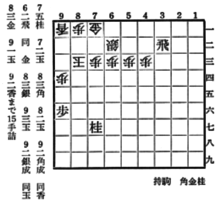
In the Japanese system, the notation string has the following 5-part format:
1 2 3 4 5 (player side) destination piece (movement) (promotion)
A typical move is indicated like 8六歩 (= P-8f). An example that uses all 5 parts is ☗8三銀引成 (which could be either S7b-8c+ or S7bx8c+ in western notation).
1. Player's Side. It is common for the white (gote) and black (sente) player to be indicated at the beginning of the notation string with either black and white triangles (▲/△) or shogi-piece-shaped pentagons (☗/☖) , such as ▲7六歩△3四歩▲2六歩△3二金 or ☗7六歩☖3四歩☗2六歩☖3二金. However, this is not obligatory: several books notate shogi moves without explicit indication of which player is making the moves. (See the adjacent image for an example.) In such cases, knowing which player the move refers to can be determined by the context in the book. This white/black convention is more common when the moves are not numbered (which is also optional to notate).
2. Destination Coordinates. For the board's coordinates, the file is indicated with an Arabic numeral followed by the rank indicated with a Japanese numeral (instead of a letter like in the western system). For example, square 2c in Western notation is 2三.
Japanese Rank Coordinate Arabic Equivalent Western Equivalent 一 1 a 二 2 b 三 3 c 四 4 d 五 5 e 六 6 f 七 7 g 八 8 h 九 9 i
There is also an abbreviatory convention: when a piece moves to the same coordinates as the previous move's piece (as in a capture), the position is simply indicated with 同 (which is pronounced dō) instead of the file-rank coordinate numbers. For example, if Black's pawn moved to a square in which White's pawn captured Black's pawn and then both player's bishops recaptured followed by a rook recapture, this could be notated as ☗2四歩 ☖同歩 ☗同角 ☖同角 ☗同飛 which would be equivalent to the western notation sequence 1. P-2d Px2d, 2. Bx2d Bx2d, 3. Rx2d.
3. Piece. Pieces are indicated with kanji (instead of letters as in the western system). The piece's kanji follows the piece's board coordinates. The following symbols are used.
Japanese Western Equivalent Japanese Western Equivalent 歩 P と +P 香 L 成香 +L 桂 N 成桂 +N 銀 S 成銀 +S 角 B 馬 +B 飛 R 龍 +R 金 G 玉 K
Promoted pieces are indicated with a 成 prefix except for the promoted pawn, promoted bishop, and promoted rook, which are と, 馬, 龍, respectively.
4. Ambiguity Resolution: Movement Description. When there is ambiguity in piece movement, there is a complex system of movement description using the symbols below. The movement descriptors consist of (a) a dropped piece indicator, (b) movement toward destination indicators, and (c) movement origin indicators.
Movement Notation Meaning 打 dropped 引 downward 寄 horizontally 上 upward 右 moving from right (going leftwards) 左 moving from left (going rightwards) 直 perpendicularly vertical (gold/silver only) 行 upward (dragon/horse) 入 upward (dragon/horse)
The symbol for a dropped piece is 打 following the piece's character. In the usual course of a game, most dropped pieces will probably be unambiguous. In these unambiguous cases, explicit notation for the dropped piece is not required and usually omitted (unlike in western notation where the drop notation is obligatory). For example, a western notation such as P*2c will be notated simply as 2三歩 instead of 2三歩打. In other situations, there is a possibility that either a piece that is already in play on the board can move to a certain square or a piece of the same kind that is held in hand can be dropped to that square. In this case, when the piece on the board moves to that square, the notation simply notates the move as usual with no drop indication. However, when the piece in hand is dropped to that location, then the drop indication must be present in the notation in order to resolve the ambiguity. In other words, 打 is only used when the following two conditions are met: (i) a piece is dropped and (ii) there is ambiguity with another piece on the board.
For ambiguity resolution with pieces on the board, the main notation symbols are 引 for upward movement, 寄 for horizontal movement, and 上 for downward movement. Note that these three indicators describe movement toward their destination square.
In the example below, three golds can move to the 7八 (= 7h) square. The gold that originates on 7七 (= 7g) and moves down is notated as 7八金引 (= G7g-7h). The other two possibilities are notated as 7八金寄 (= G6h-7h) and 7八金上 (= G7i-7h).
|
|
|
|
The 引 and 上 indicate downward and upward movement, respectively, that can be both vertical as well as diagonal.
|
|
|
There are two less common alternate symbols used instead of 上: 行 and 入. However, these alternate symbols are reserved for indicating only the two most powerful promoted dragon 龍 and horse 馬 pieces. Thus, 5五龍行 or 5五龍入 instead of 5五龍上, but not 5五金行 or 5五金入.
In certain situations, an indication of movement toward the destination square (that is, with 引, 寄, 上) is not sufficient to resolve ambiguity. In these cases, the origin square of the piece is notated with a relative positional indicator. These are 右 for a piece moving from a right square (and thus moving leftward) and 左 for a piece moving from a left square (rightward).
|
|
|
This positional information is relative to each player's directions. Thus, △5二金右 ("white 5-2 gold right") refers to the silver on the right from White's perspective (which would be on the left from Black's perspective).
|
|
In the special case of golds and silvers as well as promoted pieces with gold-like movements (成銀, 成桂, 成香, と), it is possible for there to a 3-way ambiguity in upward movement. In this case, a third positional origin indicator is used: 直 for vertical (straight up) movement.
|
|
|
|
Additionally, this 直 indicator tends to always be used for vertical movement even when simply using 右 ("right") and 左 ("left") would suffice. Relatedly, 直 tends to be used only for golds and silvers and not for other pieces.
|
|
|
5. Promotion. A piece that promotes is indicated with 成 following the piece's character, such as 7三桂成 (N-7c+). If a piece does not promote, this is indicated with 不成 following the piece's character, such as 7三桂不成 (N-7c=). There is an alternate symbol for unpromotion: 生 is sometimes used instead of 不成.
Numbering. Unlike western notation, numbering Japanese game records is not obligatory. Although players' moves often aren't numbered, shogi moves are always counted per player's move. This is commonly seen in checkmate problems where a 3-move 3手 checkmate problem would mean a move sequence of black-white-black. This is unlike western chess which counts each pair of moves as one move. (In western notation for shogi, the move numbering tends to follow western chess notation conventions.)
Game End. Shogi games are officially over when a player formally resigns. The resignation is notated as 投了 tōryō. Other possible endings include 千日手 Repetition Draw and the very rare 待将棋 Draw.
Unlike western notation, a capture of a piece is never explicitly notated in the Japanese system since the capture can be understood in the context of the game.
Examples
As an example, a One-turn Loss Bishop Exchange game might proceed and be notated like this:[9]
| Notation Example 1 Board after 44 moves Gote/White Pieces-in-hand: 銀歩歩歩歩
| ||||||||||||||||||||||||||||||||||||||||||||||||||||||||||||||||||||||||||||||||||||||||||||||||||||||||||||||
| Sente/Black Pieces-in-hand: 銀歩歩 |
| Western-style Notation | Japanese-style Notation | ||||||||||||||||||||||||||||||||||||||||||||||||||||||||||||||||||||||||||||||||||||||||||||||||||||||||||||||||||||||||||||||||||||||||||||||||||||||||||||||||||||||||||||||||
|---|---|---|---|---|---|---|---|---|---|---|---|---|---|---|---|---|---|---|---|---|---|---|---|---|---|---|---|---|---|---|---|---|---|---|---|---|---|---|---|---|---|---|---|---|---|---|---|---|---|---|---|---|---|---|---|---|---|---|---|---|---|---|---|---|---|---|---|---|---|---|---|---|---|---|---|---|---|---|---|---|---|---|---|---|---|---|---|---|---|---|---|---|---|---|---|---|---|---|---|---|---|---|---|---|---|---|---|---|---|---|---|---|---|---|---|---|---|---|---|---|---|---|---|---|---|---|---|---|---|---|---|---|---|---|---|---|---|---|---|---|---|---|---|---|---|---|---|---|---|---|---|---|---|---|---|---|---|---|---|---|---|---|---|---|---|---|---|---|---|---|---|---|---|---|---|---|---|
|
|
Below is another notated game (Quick Ishida opening) showing the more typical Japanese notation where moves are not numbered, dropped pieces are not indicated, and white/black turns are marked.[10] It also shows an example of ambiguity resolution (G6i-5h/5八金左) and a piece entering a promotion zone that remains unpromoted (Sx2c=/2三銀不成).
| Notation Example 2 Board after 37 moves Gote/White Pieces-in-hand: 銀歩
| ||||||||||||||||||||||||||||||||||||||||||||||||||||||||||||||||||||||||||||||||||||||||||||||||||||||||||||||
| Sente/Black Pieces-in-hand: 歩歩 |
| Western-style Notation | Japanese-style Notation | |||||||||||||||||||||||||||||||||||||||||||||||||||||||||||||||||||||||||||||||||||||||||||||||
|---|---|---|---|---|---|---|---|---|---|---|---|---|---|---|---|---|---|---|---|---|---|---|---|---|---|---|---|---|---|---|---|---|---|---|---|---|---|---|---|---|---|---|---|---|---|---|---|---|---|---|---|---|---|---|---|---|---|---|---|---|---|---|---|---|---|---|---|---|---|---|---|---|---|---|---|---|---|---|---|---|---|---|---|---|---|---|---|---|---|---|---|---|---|---|---|---|
|
|
Strategy and tactics
Shogi is similar to chess but has a much larger game tree complexity because of the use of drops.[11] Like chess, however, the game can be divided into the opening, middle game and endgame, each requiring a different strategy. The opening consists of arranging one's defenses usually in a castle and positioning for attack, the mid game consists of attempting to break through the opposing defenses while maintaining one's own, and the end game starts when one side's defenses have been compromised.
History
| Shogi variants |
|---|
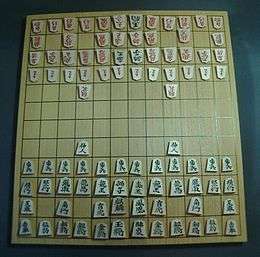 |
| Standard shogi (9×9, drops) |
| Small variants |
|
| Standard-size variants |
|
| Large variants |
|
| Multiplayer variants |
|
| 3D variants |
|
From The Chess Variant Pages:[1]
The world's first chess variant, chaturanga arose in India in approximately the seventh century AD. From there it migrated both westward and northward, mutating along the way. The western branch became shatranj in Arabia and Orthodox Chess in Europe. The northern branch became xiangqi in China and janggi in Korea. Sometime in the 10th to 12th centuries, 'chess' crossed the channel to Japan where it spawned a number of interesting variants. One of these was called 'Small Shogi'. Eventually, Small Shogi (though it went through many forms) won out over the larger variants and is now referred to simply as 'Shogi'. It is certain that Shogi in its present form was played in Japan as early as the 16th century.
It is not clear when chess was brought to Japan. The earliest generally accepted mention of shogi is Shin Saru Gakuki (新猿楽記) (1058–64) by Fujiwara Akihira. The oldest archaeological evidence is a group of 16 shogi pieces excavated from the grounds of Kōfuku-ji in Nara Prefecture. As it was physically associated with a wooden tablet written on in the sixth year of Tenki (1058), the pieces are thought to date from that period. These simple pieces were cut from a writing plaque in the same five-sided shape as modern pieces, with the names of the pieces written on them.
The dictionary of common folk culture, Nichūreki (二中歴) (c. 1210–21), a collection based on the two works Shōchūreki (掌中歴) and Kaichūreki (懐中歴), describes two forms of shogi, large (dai) shogi and small (shō) shogi. These are now called Heian shogi (or Heian small shogi) and Heian dai shogi. Heian small shogi is the version on which modern shogi is based, but the Nichūreki states that one wins if one's opponent is reduced to a single king, indicating that drops had not yet been introduced. According to Kōji Shimizu, chief researcher at the Archaeological Institute of Kashihara, Nara Prefecture, the names of the Heian shogi pieces keep those of chaturanga (general, elephant, horse, chariot and soldier), and add to them the five treasures of Buddhism (jade, gold, silver, katsura tree, and incense).
Around the 13th century the game of dai shogi developed, created by increasing the number of pieces in Heian shogi, as was sho shogi, which added the rook, bishop, and drunken elephant from dai shogi to Heian shogi. Around the 15th century, the rules of dai shogi were simplified, creating the game of chu shogi in a form close to the modern game. It is thought that the rules of standard shogi were fixed in the 16th century, when the drunken elephant was removed from the set of pieces. There is no clear record of when drops were introduced, however.
In the Edo period, shogi variants were greatly expanded: tenjiku shogi, dai dai shogi, maka dai dai shogi, tai shogi, and taikyoku shogi were all invented. It is thought that these were played to only a very limited extent, however. Both standard shogi and Go were promoted by the Tokugawa shogunate. In 1612, the shogunate passed a law giving endowments to top shogi players (Meijin (名人)). During the reign of the eighth shogun, Tokugawa Yoshimune, castle shogi tournaments were held once a year on the 17th day of Kannazuki, corresponding to November 17, which is Shogi Day on the modern calendar.
The title of meijin became hereditary in the Ōhashi and Itō families until the fall of the shogunate, when it came to be passed by recommendation. Today the title is used for the winner of the Meijin-sen competition, the first modern title match. From around 1899, newspapers began to publish records of shogi matches, and high-ranking players formed alliances with the aim of having their games published. In 1909, the Shogi Association (将棋同盟社) was formed, and in 1924, the Tokyo Shogi Association (東京将棋連盟) was formed. This was an early incarnation of the modern Japan Shogi Association (日本将棋連盟 nihon shōgi renmei), or JSA, and 1924 is considered by the JSA to be the date it was founded.[12]
In 1935, meijin Kinjirō Sekine stepped down, and the rank of meijin came to be awarded to the winner of a Meijin title match (名人戦 meijin-sen). Yoshio Kimura (木村義雄) became the first Meijin under this system in 1937. This was the start of the shogi title matches (see titleholder system). After the war other tournaments were promoted to title matches, culminating with the Ryūō title match (竜王戦 ryūō-sen) in 1988 for the modern line-up of seven. About 200 professional shogi players compete. Each year, the title holder defends the title against a challenger chosen from knockout or round matches.
After the Second World War, SCAP (occupational government mainly led by US) tried to eliminate all "feudal" factors from Japanese society and shogi was included in the possible list of items to be banned along with Bushido (philosophy of samurai) and other things. The reason for banning shogi for SCAP was its exceptional character as a board game seen in the usage of captured pieces. SCAP insisted that this could lead to the idea of prisoner abuse. But Kozo Masuda, then one of the top professional shogi players, when summoned to the SCAP headquarters for an investigation, criticized such understanding of shogi and insisted that it is not shogi but western chess that potentially contains the idea of prisoner abuse because it just kills the pieces of the opponent while shogi is rather democratic for giving prisoners the chance to get back into the game. Masuda also said that chess contradicts the ideal of gender equality in western society because the king shields itself behind the queen and runs away. Masuda’s assertion is said to have eventually led to the exemption of shogi from the list of items to be banned.[13]
The closest cousin of shogi in the chaturanga family is makruk of Thailand. Not only the similarity in distribution and movements of the pieces but also the names of shogi pieces suggest intimacy between shogi and makruk by its Buddhist symbolism (gold, silver, Cassia and Incense), which is not recognized in Chinese chess at all. In fact, Chinese chess and its East Asian variants are far remoter relatives than makruk. Though some early variants of chaturanga more similar to shogi and makruk are known to have been played in Tang dynasty China, they are thought to have been extinguished in Song dynasty China and in East Asia except in Japan probably owing to the popularity of Chinese chess.
Tournament play
There are two organizations for shogi professional players in Japan: the JSA, and the Ladies' Professional Shogi-players' Association of Japan (日本女子プロ将棋協会 nihon joshi puro shōgi kyōkai), or LPSA. The JSA is the primary organization for men and women's professional shogi[12] while the LPSA is a group of women professionals who broke away from the JSA in 2007 to establish their own independent organization.[14] Both organize tournaments for their members and have reached an agreement to cooperate with each other to promote shogi through events and other activities.[15]
The JSA recognizes two categories of shogi professionals: Professional (棋士 "Kishi"), and Female Professional (女流棋士 "Joryūkishi"). Sometimes "kishi" are addressed as Seikishi (正棋士), a term from Go used to distinguish "kishi" from other classes of players. JSA professional ranks and female professional ranks are not equivalent and each has their own promotion criteria and ranking system. In 2006, the JSA officially granted women "professional status". This is not equivalent, however, to the more traditional way of "gaining professional status", i.e., being promoted from the "Shoreikai System" (奨励会): leagues of strong amateur players aspiring to become a professional. Rather, it is a separate system especially designed for female professionals. Qualified amateurs, regardless of gender, may apply for the "Shoreikai System" and all those who successfully "graduate" are granted "kishi" status; however, no woman has yet to accomplish this feat (the highest women have reached is Kana Satomi in "Shoreikai 3 dan league", currently one step away from "kishi" status), so "kishi" is de facto only used to refer to male shogi professionals.[16]
The JSA is the only body which can organize tournaments for "professionals", e.g., the seven major tournaments in the titleholder system and other professional tournaments. In 1996, Yoshiharu Habu became the only "kishi" to hold all seven existing major titles at the same time. For female professionals, both the JSA and LPSA organize tournaments, either jointly or separately. Tournaments for amateurs may be organized by the JSA and LPSA as well as local clubs, newspapers, private corporations, educational institutions or municipal governments for cities or prefectures under the guidance of the JSA or LPSA.
Since the 1990s, shogi has grown in popularity outside Japan, particularly in the People's Republic of China, and especially in Shanghai. The January 2006 edition of Kindai Shogi (近代将棋) stated that there were 120,000 shogi players in Shanghai.[17] The spread of the game to countries where Chinese characters are not in common use, however, has been slower.
Etiquette
Shogi players are expected to follow etiquette in addition to rules explicitly described. Commonly accepted etiquette include following:
- greetings to the opponent both before and after the game.
- avoiding disruptive actions both during the game and after, for instance:
- not changing the move once realized on the board.
- fair withdrawal without any disruption, such as scattering pieces on the board to demonstrate frustration.
Shogi piece sets may contain two types of king pieces, 王 (king) and 玉 (jewel). In this case, the higher classed player, in either social or genuine shogi player rank, may take the king piece. For example, in titleholder system games, the current titleholder takes the king piece as the higher.
Computer shogi
Shogi has the highest game complexity of all popular chess variants. Computers have steadily improved in playing shogi since the 1970s. In 2007, champion Yoshiharu Habu estimated the strength of the 2006 world computer shogi champion Bonanza at the level of two-dan shoreikai.
The JSA prohibits its professionals from playing computers in public without prior permission, with the reason of promoting shogi and monetizing the computer-human events.[18]
On October 12, 2010, after some 35 years of development, a computer finally beat a professional player, when the top ranked female champion Ichiyo Shimizu was beaten by the Akara2010 system in a game lasting just over 6 hours.[19]
On July 24, 2011, computer shogi programs Bonanza and Akara crushed the amateur team of Kosaku and Shinoda in two games. The allotted time for the amateurs was one hour and then three minutes per move. The allotted time for the computer was 25 minutes and then 10 seconds per move.[20]
On April 20, 2013, GPS Shogi defeated 8-dan professional shogi player Hiroyuki Miura in a 102-move game which lasted over 8 hours.[21]
The highest rated player on Shogi Club 24 is computer program Ponanza, rated 3455 on December 13, 2015.[22]
On April 10, 2016, Ponanza defeated Takayuki Yamasaki, 8-dan in 85 moves. Takayuki used 7 hours 9 minutes.[23]
From a computational complexity point of view, generalized shogi is EXPTIME-complete.[24]
Shogi video games
Hundreds of video games were released exclusively in Japan for several consoles.
In popular culture
Shogi has been a central plot point in manga and anime Shion no Ō, manga and television series 81diver and manga March Comes in Like a Lion. It also is played in the manga and anime Prince of Stride
In the manga series Naruto, shogi plays an essential part in Shikamaru Nara's character development. He often plays it with his teacher, Asuma Sarutobi, apparently always beating him. When Asuma is fatally injured in battle, he reminds Shikamaru that the shogi king must always be protected, and draws a parallel between the king in shogi and his yet-unborn daughter, Mirai, whom he wanted Shikamaru to guide. After Asuma's death, Shikamaru realizes that Asuma really meant that the entire next generation of ninja should be protected.
The Japanese culture and lifestyle television show Begin Japanology aired on NHK World featured a full episode on shogi in 2009.
See also
References
- 1 2 "Shogi: Japanese Chess". The Chess Variant Pages. Retrieved 8 March 2012.
- ↑ "Sono Hoka no Goshitsumon: Koma no Narabikata ni Kimari wa Aru no Deshōka?" その他のご質問: 駒の並べ方に決まりはあるのでしょうか? [Other questions: Is there a certain way to set up the pieces?] (in Japanese). 日本将棋連盟 (Japan Shogi Association). Retrieved 17 December 2014.
江戸時代は, それぞれの家元に「大橋流」「伊藤流」という並べ方がありました。現在のでも, その並べ方を用いている棋士は少なからずおります. ただし, 決まりとして「このような並べ方をしなければならない」というものはありません. [In the Edo Era, each Iemoto had their own respective way of setting up the pieces: the 'Ohashi-style' and the 'Ito-style'. Although these two styles are still used today by many professionals, there is really no rule specifying that 'the pieces must be set up in this particular way'.]
- ↑ Grimbergen, Reijer. "Shogi Terms". www.shogi.net. Retrieved 22 July 2016.
- ↑ Hansoku
- ↑ "Hansoku ni Tsuite 3. ōtehōchi" 反則について3.王手放置 [About rule violations: 3. Leaving your king in check] (in Japanese). 日本将棋連盟 (Japan Shogi Association). Retrieved 17 December 2014.
王手をかけられたら, 玉が逃げるなど, 必ず王手を防ぐ手を指さなければなりません。王手がかかっているのに違う手を指すのは反則です. [When your king is placed in check, the king must escape, etc. so you must play moves that prevent checks. If your king is in check, ignoring the check and playing a different move is a violation.]
- ↑ "Shōgi no Ruru ni Kansuru Goshitsumon — Q: Taikyokuchū ni Ōte wo Kaketara, "Ōte wo Kaketa noni, 'Ōte' to Hasseishinai no wa Hansoku da" to Iwaremashita. Sonoyō na Kitei wa Aru no Deshōka." 将棋のルールに関するご質問 — Q: 対局中に王手をかけたら, 「王手をかけたのに,『王手』と発声しないのは反則だ」と言われました。そのような規定はあるのでしょうか。 [Questions about the Rules of Shogi — Q: I've been told that not saying "Ote" when you place your opponent in check is against the rules. Is there really such a rule?]. 日本将棋連盟 (Japan Shogi Association). Retrieved 9 December 2014.
A: たまにそういう主張をされる方がいらっしゃいますが, そのような規定は一切ありません。 [A: Occasionally you will hear such a thing being asserted, but there is absolutely no such rule at all.]
- ↑ "Shōreikai Gaiyō" 奨励会概要 [Outline of Shoreikai] (in Japanese). Japan Shogi Association. Retrieved 21 September 2015.
- ↑ "Title offset illustration". Retrieved 8 March 2012.
- ↑ These are the first 44 moves of an Asahi Trophy Open game by Akira Inaba and Mamoru Hatakeyama on 2008 November 13. "2008年11月13日 畠山 鎮七段 - 稲葉 陽四段". Asahi archives. Retrieved 30 April 2016.
- ↑ These are the first 37 moves of an Mynavi Women's Open by Saori Shimai and Haruko Saida on 2009 October 21. "マイナビ女子オープン". Retrieved 9 May 2016.
- ↑ Hitoshi Matsubara, Reijer Grimbergen. "Differences between Shogi and western Chess from a computational point of view". Proceedings: Board Games in Academia.
- 1 2 "Sōritsu・Enkaku" 創立・沿革 [Founding and History] (in Japanese). 日本将棋連盟 (Japan Shogi Association). Retrieved 16 August 2012.
- ↑ Masuda, Kozo (2003). Meijin ni Kyosha wo Hiita Otoko 名人に香車を引いた男 [The Man Who Gave A Lance Handicap To A Meijin]. Chuokoron-Shinsha. p. 223. ISBN 978-4122042476.
- ↑ "Enkaku" 沿革 [LPSA History] (PDF) (in Japanese). 日本女子プロ将棋協会 (Ladies' Professional Shogi-players' Association of Japan). Retrieved 26 June 2014.
- ↑ "Nihon Joshi Puro Shōgi Kyōkai (LSPA) to Gōisho Teiketsu" 日本女子プロ将棋協会 (LPSA)と合意書締結 [Agreement signed with LPSA] (in Japanese). 日本将棋連盟 (Japan Shogi Association). 2 June 2014. Retrieved 26 June 2014.
- ↑ "Yoku Aru Goshitsumon: Naze, Dansei wa "Kishi" na no ni, Josei wa "Joryūkishi" to Naru no Desuka" よくあるご質問:なぜ、男性は「棋士」なのに、女性は「女流棋士」となるのですか。 [FAQ: Why are men referred to as "kishi" and women referred to as "joryūkishi"?] (in Japanese). 日本将棋連盟 (Japan Shogi Association). Retrieved 28 June 2014.
- ↑ "shogi population of 120,000 people".
- ↑ "Shogi pros warned not to play computers". The Japan Times. Tokyo, Japan. 16 October 2005. Retrieved 28 November 2011.
- ↑ "Top female 'shogi' pro falls to computer". Japan Times. Kyodo. 12 October 2010. Retrieved 17 December 2014.
- ↑ "Shōgi Sofuto ni Amagumi Kanpai: Hijutsu, Ikki ni Semetsubusareru" 将棋ソフトにアマ組完敗 秘術、一気に攻めつぶされる [Shogi computer programs crush amateurs]. The Asahi Shimbun (in Japanese). 2 August 2011. Retrieved 17 December 2014.
- ↑ "Dainikai Shōgi Denōsen Daigokyoku Miura Hiroyuki vs GPS Shōgi" 第2回 将棋電王戦 第5局 三浦弘行八段 vs GPS将棋 [Second Shogi Denosen, Game 5: Hiroyuki Miura 8 dan vs. GPS Shogi] (in Japanese). Niwango. Retrieved 17 December 2014.
- ↑ "Computer program Bonkras highest rated player on Shogi Club 24" (in Japanese). Shogi Club 24.
- ↑ Shinji, Fukamatsu. "AI beats top shogi player in first match of tournament final:The Asahi Shimbun". The Asahi Shimbun. Retrieved 17 May 2016.
- ↑ H. Adachi; H. Kamekawa; S. Iwata (1987). "Shogi on n × n board is complete in exponential time". Trans. IEICE. J70-D: 1843–1852.
Bibliography
- SHOGI Magazine (70 issues, January 1976 – November 1987) by The Shogi Association (edited by George Hodges)
- Aono, Teruichi (1983). Better Moves for Better Shogi. translated by John Fairbairn. Tokyo, Japan: Sankaido Publishing Co., Ltd. ISBN 978-4381005977.
- Aono, Teruichi (1983). Guide to Shogi Openings: Shogi Problems in Japanese and English. translated by John Fairbairn. Tokyo, Japan: Sankaido Publishing Co., Ltd. ISBN 978-4381005984.
- Fairbairn, John (1984). Shogi for Beginners. Tokyo: Kiseido Publishing Company. ISBN 4-906574-97-1.
- Habu, Yoshiharu; Hosking, Tony (2000). Habu's Words. translated by Tony Hosking and Yamato Takahashi. Stratford-upon-Avon, England: The Shogi Foundation. ISBN 978-0953108923.
- Hosking, Tony (1997). The Art of Shogi. Stratford-upon-Avon, England: The Shogi Foundation. ISBN 978-0953108909.
- Hosking, Tony (2006). Classic Shogi: Games Collection. Stratford-upon-Avon, England: The Shogi Foundation. ISBN 978-0953108930.
- Pritchard, D. B. (1994). "Shogi". The Encyclopedia of Chess Variants. Games & Puzzles Publications. pp. 269–79. ISBN 0-9524142-0-1.
External links
| Wikimedia Commons has media related to Shogi. |
- Shogi en Español Asociation (Spain)
- Shogi.Net
- Reijer Grimbergen's Shogi Page
- Ricoh Shogi Page
- Shogi.es Spanish-language shogi site
Rules
- 40 shogi lessons on YouTube by HIDETCHI
- An Introduction to Shogi for Chess Players
- Shogi by Hans Bodlaender and Fergus Duniho, The Chess Variant Pages
- Rules and Manners of Shogi by Tomohide Kawasaki (a.k.a. HIDETCHI)
- Shogi, the Japanese Chess by Jean-Louis Cazaux
- Small Shogi Variants by Georg Dunkel
- Shogi and Dobutsu-Animal shogi rules to download by Filip Marek
Online play
- 81 Dojo English-language shogi play online
- Shogi Dojo 24 English-language shogi server in Japan
- GoldToken online turn-based shogi
- HamShogi handicap shogi against the computer, instructions
- boardspace.net real time play against human or (weak) computer players.
- Spear a shogi engine
- Western Style Print and Play Shogi Set for sale
